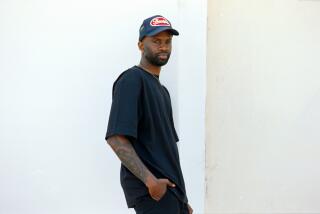ART REVIEWS: VARIEGATED EXPERIENCES : ‘Cordoned Heart’ Photo Exhibit at UCLA Lacks Soul of South Africa
- Share via
“South Africa: The Cordoned Heart,” an exhibition of photographs by 20 South African social activists, tackles a subject so loaded that it’s difficult to approach the pictures with equanimity. That’s fortunate because the show needs all the preconceived emotion we can muster.
Even more, it depends upon words: catalogue text, labels and photographers’ quotes enlarged on red banners. The photos alone, at UCLA’s Museum of Cultural History in Haines Hall through May 17, simply don’t convey the horrors of a situation that is painfully familiar to millions who have seen it only on television and in newspapers.
As Bishop Desmond Tutu writes in the catalogue, the 60 black-and-white images do put a face on South African poverty. But if we weren’t informed that the grim, overworked black people who live in stark squalor are victims of a government that makes their predicament a policy, we might imagine them to be citizens of any of a dozen other countries--including our own.
A woman cleaning a huge table by crawling on it, in a photo by Lesley Lawson, could be working in a Manhattan board room instead of in Johannesburg. Except for the labels on bags and bottles,Michael Davies’ shot of a segregated beach party might have been taken in Southern California. People sleeping during long commutes via public transport, in David Goldblatt’s work, could be traveling in an international array of cities. Only photos that sweep the barren countryside or focus on dismal compounds unequivocally say “South Africa.”
Instead of proving the old adage--that a picture is worth a thousand words--the show offers photos that require explanation. Apparently this was obvious to UCLA curators who include sufficient supporting text to let every visitor know that “The Cordoned Heart” is a political exhibition.
Those who prefer not to confront hard-hitting images of brutality or gut-wrenching suffering will find that the photographers have done a good job of documenting life among the disenfranchised. In some of Davies’ work, that life appears to go on quite happily at an amusement park and a soccer game. Other pictures present a display of dignity and strength as people attend political conferences, meet at public rallies and mourn on funeral marches.
A far more damning view permeates shots of rickety pensioners, women who must walk miles to gather firewood and water, and children attending school in shanties. Despite photography’s failure to fully grasp South Africa’s social catastrophe, “The Cordoned Heart” succeeds in presenting an affecting human document.
But if you really want to get the full picture--and to see more photographs--read the catalogue. It is a clearly written, moving report published in 1984 in conjunction with the Second Carnegie Inquiry Into Poverty and Development in Southern Africa.
The exhibition, now on a national tour, was organized by the International Center of Photography in New York and the Center for Documentary Photography at Duke University. Museum hours: Wednesday through Sunday, noon to 5 p.m.
More to Read
The biggest entertainment stories
Get our big stories about Hollywood, film, television, music, arts, culture and more right in your inbox as soon as they publish.
You may occasionally receive promotional content from the Los Angeles Times.










